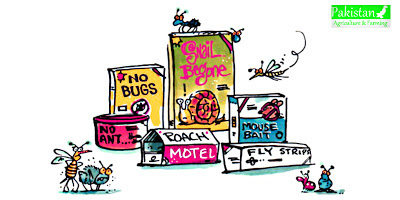An insecticide is a pesticide used against insects.
2. Contact Insecticides
3. Natural Insecticides
4. Plant-Incorporated Protectants (PIPs)
5. Inorganic Insecticides
6. Organic Insecticides
1. Organochlorine Compounds (OC)
2. Organophosphorous Compounds (OP)
3. Carbamates (C)
4. Pyrethrins/Synthetic Pyrethroids (SP)
5. Others like Neonicotinoides, Insect Growth Regulators (IGRs), Pheromones etc.
They include ovicides, larvicides and adulticides used against the eggs, larvae and adults of insects, respectively. The use of insecticides has been very popular since the arrival of first synthetic chemical insecticides during the days of world war 2.
 |
| Insecticides cartoon |
Types of Insecticides
1. Systemic Insecticides2. Contact Insecticides
3. Natural Insecticides
4. Plant-Incorporated Protectants (PIPs)
5. Inorganic Insecticides
6. Organic Insecticides
Synthetic Organic Insecticides
The synthetic organic insecticides are relatively new compounds. The first synthetic organic insecticide DDT was synthesized in 1874, and its insecticidal properties were first recognized in 1939.
During World War II, research in nerve gases led to the discovery of additional compounds that are effective insecticides.
During World War II, research in nerve gases led to the discovery of additional compounds that are effective insecticides.
Groups of Synthetic Organic Insecticides
The organic insecticides are split up into the following main groups:1. Organochlorine Compounds (OC)
2. Organophosphorous Compounds (OP)
3. Carbamates (C)
4. Pyrethrins/Synthetic Pyrethroids (SP)
5. Others like Neonicotinoides, Insect Growth Regulators (IGRs), Pheromones etc.
 |
| Classification of Synthetic Organic Insecticides |

